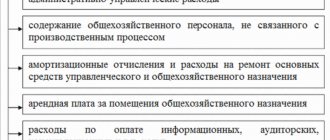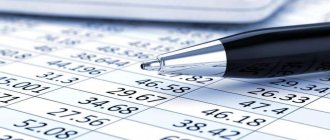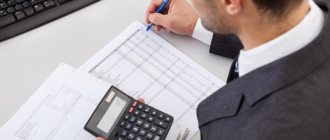How to account for expenses using the cash method
As a general rule, in accounting, expenses are recognized in the reporting period in which they occurred, regardless of the time of actual payment of funds (assuming the temporary certainty of the facts of economic activity). Organizations that have the right to use simplified accounting methods, including simplified accounting (financial) reporting, can use the cash method of accounting for income and expenses. Under the cash method, revenue from the sale of goods (work, services) is recognized after receipt of cash and other forms of payment, and expenses - after repayment of debt (clause 18 PBU 10/99 “Organization expenses”, approved by order of the Ministry of Finance of Russia dated 05/06/1999 No. 33n).
In “1C: Accounting 8” (rev. 3.0), revenue and expenses for accounting purposes can be accounted for without closing documents (“on payment”). With certain assumptions, this method of accounting can be considered the cash method. This method is only available to those who use the following special tax regimes:
- simplified taxation system (STS) with the object “income”;
- unified tax on imputed income (UTII);
- patent taxation system (PTS).
Accounting for expenses in the program without closing documents is based on the assumption that expenses for the purchase of goods (work, services) relate to the reporting period in which they were paid. And settlements with the supplier are made at the time of purchase of goods (works, services).
To use this method in the documents Debiting from a current account and Cash issuance (with the transaction type Payment to supplier), it is enough to select the method Without closing documents in the Payments indicator. When posting documents with the specified setting, an expense is recognized, which is reflected by the posting:
Debit 44 (26) Credit 51 (50.01) - for the amount of payment to the supplier.
The account specified in the Main cost account field of the Accounting Policy information register is substituted as a cost account.
The applied methodology for accounting for income and expenses should be fixed in the accounting policy for accounting purposes.
When applying special tax regimes, tax accounting is carried out only on a cash basis:
- under the simplified tax system - in accordance with paragraph 1 of Article 346.17 of the Tax Code of the Russian Federation;
- for PSN - in accordance with Article 346.53 of the Tax Code of the Russian Federation;
- when combining UTII with the simplified tax system, UTII income is also determined by the cash method (letter of the Ministry of Finance of Russia dated November 23, 2009 No. 03-11-06/3/271).
In “1C: Accounting 8” (rev. 3.0), tax accounting of income and expenses for special regimes is automated and supported through special mechanisms, including through the use of special accumulation registers. Entries in registers are entered, as a rule, automatically when posting documents that record business transactions.
In general, the accrual method is used for income tax purposes. With regard to expenses, this means that they are taken into account in the reporting (tax) period to which they relate, and are recognized in the presence of income for the receipt of which they were incurred (Clause 1, Article 272, Article 318-320 of the Tax Code of the Russian Federation).
A number of organizations have the right to determine the date of receipt of income (expense) using the cash method, if on average over the previous 4 quarters the amount of sales revenue excluding VAT did not exceed 1 million rubles. for each quarter (clause 1 of article 273 of the Tax Code of the Russian Federation). In 1C: Accounting 8, the cash method for income tax payers is not supported.
Recognition rules in financial statements. results
Expenses are recognized in the income statement based on the following rules:
- taking into account the relationship between expenses incurred and revenues (correspondence between income and expenses);
- by their reasonable distribution between reporting periods - when expenses determine the receipt of income over several reporting periods and when the relationship between income and expenses cannot be clearly defined or is determined indirectly;
- for expenses recognized in the reporting period when the non-receipt of economic benefits (income) or receipt of assets becomes determined;
- regardless of how they are accepted for the purposes of calculating the tax base;
- when obligations arise that are not caused by the recognition of the corresponding assets.
Read also
30.01.2019
What settings need to be made in 1C to account for direct and indirect costs
The concepts of direct and indirect expenses in accounting and tax accounting are different.
In accounting, expenses are divided into direct and indirect, depending on the methods of inclusion in the cost of certain types of products. Direct costs are understood as those costs that are associated with the production of certain types of products and that can be directly and directly included in their cost. By indirect we mean costs associated with the production of several types of products, included in their cost using special methods (clause 20 of the “Basic provisions for planning, accounting and calculating the cost of products at industrial enterprises”, approved by the State Planning Committee of the USSR, the State Committee for Prices of the USSR, the Ministry of Finance of the USSR , Central Statistical Office of the USSR 07/20/1970).
The procedure for accounting for costs of producing products, selling goods, performing work and providing services in the context of elements and items, calculating the cost of products (work, services) is established by industry regulations and guidelines for accounting (clause 10 of PBU 10/99).
Direct expenses are recorded in accounts 20 “Main production”, 23 “Auxiliary production”, 29 “Service production and facilities”. Indirect expenses are accounted for in accounts 25 “General production expenses” and 26 “General economic expenses” (Chart of accounts for accounting of financial and economic activities of organizations, approved by order of the Ministry of Finance of Russia dated October 31, 2000 No. 94n).
For profit tax purposes, direct expenses may include costs directly related to the production of products, performance of work, provision of services (material costs, personnel costs, insurance premiums, depreciation of fixed assets). The organization has the right to determine the list of direct costs associated with the production of products (performance of work, provision of services). Indirect expenses include expenses incurred in the reporting (tax) period and not classified as direct or non-operating expenses (clause 1 of Article 318 of the Tax Code of the Russian Federation).
Direct expenses can be included in the expenses of the current reporting (tax) period only in the amount attributable to the sold products, works, services in the cost of which they are taken into account. And indirect expenses are included in full in the expenses of the period in which they are incurred (clause 2 of article 318 of the Tax Code of the Russian Federation).
The procedure for classifying expenses as direct or indirect must be economically justified and determined by the specifics of the technological process, and costs can be classified as indirect only if there is no real possibility of classifying them as direct (letter of the Ministry of Finance of Russia dated September 5, 2018 No. 03-03-06/ 1/ 63428).
The specifics of determining expenses for trade operations are determined by Article 320 of the Tax Code of the Russian Federation. For trading operations, direct costs include:
- the cost of purchasing goods sold in a given reporting (tax) period;
- the amount of costs for the delivery of purchased goods (transportation costs), if these costs are not included in the purchase price of the specified goods.
All other expenses of trading organizations incurred in the current month, with the exception of non-operating expenses, are recognized as indirect expenses and reduce the income from sales of the current month.
Now about the settings of “1C: Accounting 8”. To reflect production operations, the corresponding functionality must be enabled in the program (section Main - Functionality). On the Production tab, set the flag of the same name.
Methods for distributing indirect costs to include them in the cost of products (works, services) are indicated in the accounting policy settings (section Main - Accounting Policy).
The list of direct expenses for profit tax purposes is indicated in the register Methods for determining direct production expenses in NU. This register is available via the link List of direct expenses from the Income Tax form (section Main - Taxes and reports - Income Tax).
Let's take a closer look at the accounting policy settings (Fig. 3).
Rice. 3. Accounting policies
Please note that some of these settings affect the treatment of direct and indirect expenses in tax accounting.
If an enterprise produces products and/or performs work (provides services) to customers, then it is necessary to enable the flags Production of products and/or Performance of work, provision of services to customers. If at least one of the specified flags is set, the following become available in the Accounting policy form:
- block of settings for accounting general expenses;
- link Methods for allocating indirect costs
; - block of settings for calculating production costs.
In the general expenses accounting settings block there is a General expenses included switch, which can be set to one of the positions:
- In cost of sales (direct ct-costing
). All expenses recorded on account 26 will be written off to the financial result (to account 90.08 “Management expenses”) in the period of their implementation. In tax accounting, these expenses will also be indirect (regardless of the rules established for them in the register Methods for determining direct production costs in NU); - In the cost of products, works, services. All expenses recorded on account 26 will be written off to direct expenses (for example, to account 20.01) in accordance with the procedure specified in the register Methods for distributing general production and general business expenses.
The link Methods for distributing indirect expenses takes you to the register form Methods for distributing general production and general business expenses. The register is intended to store rules for the distribution of general production and general business expenses accounted for in accounts 25 and 26. The Distribution Base field is required, where you can select one of the values:
- Issue volume;
- Planned production cost;
- Salary;
- Material costs;
- Revenue;
- Direct costs;
- Individual items of direct costs;
- Not distributed.
General and general production expenses will be distributed in proportion to the indicator specified in the Allocation Base (for example, the volume of products produced in the current month and services provided, expressed in quantitative terms, etc.).
For general production and general business expenses, you can set the distribution method with detailing down to the department and cost item. This may be necessary when different types of expenses require different distribution methods.
If it is necessary to establish a single distribution method for all general and general production expenses, then when setting the distribution method, you do not need to specify the cost account, division and cost item. You can also set a general distribution method for all expenses accounted for in one account or in one department.
When establishing the distribution method, the register indicates the date from which the distribution method is applied. If it is necessary to change the method of distribution of expenses, a new entry is entered into the information register, which indicates the new method of distribution and the date from which the new method should be applied.
As for trading organizations, no special settings in the Accounting Policy will be required to account for direct expenses.
In accounting and tax accounting, the amount of transportation costs for purchased goods can be included:
- in the cost of goods (for example, using the document Receipt of additional expenses);
- as part of the company’s sales expenses - to account 44.01 “Distribution costs in organizations engaged in trading activities” (for example, using the document Receipt ( act, invoice)
with the type of Service). In order for transportation expenses to be calculated and written off automatically, when registering the receipt of services from a transport company, you must select the value of the expense type as Transportation expenses.
When closing a month using the regulatory operation Closing account 44 “Distribution costs”, sales expenses accounted for on account 44 are written off to account 90.07.1 “Sales expenses for activities with the main tax system” as follows:
- amounts of transportation costs - only in relation to goods sold;
- all other expenses are in full.
| 1C:ITS For more information about closing cost accounts using examples, including accounting for transportation expenses, see the section “Instructions for accounting in 1C programs.” |
Results
Companies develop the grouping and used cost items independently, based on the norms of PBU 10/99, the chart of accounts and industry regulations for accounting.
In order to correctly take into account costs for accounting purposes, you should approve the list of cost items in the company’s local act and familiarize all local accounting sector specialists with it. You can find more complete information on the topic in ConsultantPlus. Free trial access to the system for 2 days.
What settings determine the result of cost calculation?
Cost is the monetary expression of the costs of production and sale of products, which consists of costs associated with the use of fixed assets, raw materials, materials, fuel and energy, labor, as well as other costs for its production and sale in the production process of industrial products (clause clauses 3, 8 “Basic provisions for cost calculation”).
The result of cost calculation (the actual cost of products in accounting and tax accounting) in “1C: Accounting 8” is reflected in the calculation certificates Cost of manufactured products and services and Cost calculation (Fig. 4), which are also available from the assistant form Closing the month
(section Operations).
Rice. 4. Costing
What does this result depend on? First of all, of course, it depends on the composition of direct costs and the order of distribution of indirect ones. But not only. Direct costs in the program include:
- directly to a specific product name;
- by type of product (per product group) with subsequent distribution by product name.
To understand how this happens, let's look at the cost account of the main production. In addition to cost items (which we wrote about above), analytical accounting for account 20.01 is carried out by types of products (works, services) (subconto Nomenclature groups) and by names of products (works, services) (subconto Products).
Each item group is an element of the Nomenclature Groups directory (section Directories), and each product name is an element of the Nomenclature directory (section Directories).
The Nomenclature Groups directory stores information about goods, products, works, and services in homogeneous groups, for which aggregated accounting of sales revenue and production costs is maintained.
The use of nomenclature groups is based on the assumption that many names of goods, products, works and services can be combined into groups with a homogeneous material composition.
Nomenclature is a directory for storing information about inventory items (including finished products), work performed, and services provided.
To get an accurate cost calculation, you need to fill in the Products field in production cost accounting documents (for example, Production Report for a Shift, Receipt from Processing, Request Invoice, etc.).
The Products field can be left blank for those costs for which it is either unknown or impractical to determine what specific product they were spent on. In this case, direct costs are distributed across the product group in a certain way.
| 1C: Accounting 8: setting up accurate cost calculations taking into account the use of specific materials |
How will direct costs be distributed within the item group? This depends on the accounting policy settings in the settings block for calculating the cost of production (see Fig. 3).
If the Use planned production cost flag is checked, then planned prices must be indicated in documents for the release of finished products and the provision of production services. Direct costs not allocated to specific products will be distributed within the product group in proportion to the planned cost.
If the Use planned production cost flag is not set, then planned prices are not required to be indicated in production documents. Costs that are direct in relation to the product group will be distributed in proportion to the costs that are direct in relation to specific products.
In any case, the actual cost is determined at the end of the month when performing a routine operation to close cost accounts.
| 1C: Accounting 8: how to distribute direct production costs without using planned cost |
Classification of expenses for decision making and control
In the course of cost analysis and management, the degree of return from the use of certain types of resources is revealed, directions for maximum cost savings are determined, which contribute to an increase in the intensity of production activities and sales volumes.
Management decision-making is based on the study of expenses, divided into:
- explicit and alternative;
- variable, constant, semi-variable;
- non-refundable;
- taken into account, not taken into account.
The process of regulation and control of spending is carried out taking into account their division into regulated options (by executors of a certain level of management), unregulated (independent of the orders of executors, mainly lower levels of management) within the limits of:
- estimates;
- planned indicators;
- standards.
Identification and analysis of deviations from norms or plans serve as the basis for cost management decisions made by managers at different levels.
A detailed classification of costs by location, taking into account the organizational division of the company, makes it possible to determine for each division one - basic - indicator that takes into account the load of a specific area and reflects the dependence of costs on output.
Various types of cost classifiers contribute to the quality management of the company as a whole by management and financial management through timely and effective cost management.
Types of accounting for transactions carried out
Expenses are reflected in the following ways:
- The first type of accounting is synthetic. It is carried out for ordinary and other types of activities within the framework of synthetic accounts based on the current chart of accounts of the company.
- Analytical accounting should create a detailed picture of them within each type of cost by division of the company and detailed items, as well as by assortment list.
This is how expenses for future periods are accounted for; transactions are compiled according to synthetic and analytical accounts.
How do expense accounts work in accounting?
The essence of how “cost accounts” work can be understood from its definition at the beginning of the article. It shows that cost accounts work in two directions:
Direction 1: Some accounts collect information about the costs incurred and expenses of the company in the course of its activities. These accounts include: 26 for services, 44.X for trade or production, 91.2 for all types of activities.
Direction 2: Other accounts are used to obtain the cost of products or work performed by the company.
For manufacturing enterprises, a whole bunch of accounts work for this: 20, 23, 25, 26, 28, 29. For companies performing simple work, the list of accounts is simpler and is represented mainly by 20 and 26 accounting accounts.
The essence of the work of accounts in this direction is to “accumulate” the full cost of the costs and expenses incurred by the company, in order to then see the resulting cost of the finished product or work. Accounting account 20 is the final account, where all costs and expenses for manufactured products or work are collected.
Costs are collected according to the names of cost items (sub-accounts of the account). Thanks to this, it becomes possible to generate a detailed report, for example, a balance sheet for an account.




